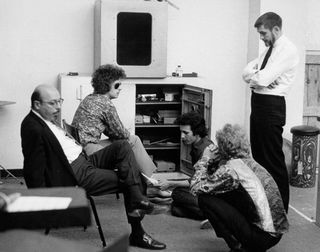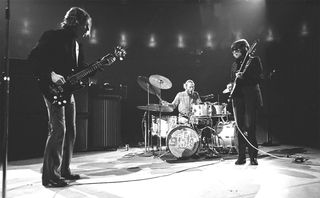“I thought of Cream as sort of a jazz band,” bassist Jack Bruce once said, “only we never told Eric he was really Ornette Coleman! Kept quiet about that.”
Like a jazz band, Cream made spirited, virtuoso improvisation a key part of their approach in concert. Together, Eric Clapton, Jack Bruce and Ginger Baker introduced jamming to rock audiences, first in concert and later on albums like Wheels of Fire, Goodbye and, following their breakup in 1968, concert discs like Live Cream and Live Cream Volume II.
Some of the longest jams in their catalog include Wheels of Fire’s “Spoonful” (16:47) and “Toad” (16:16), Goodbye’s “I’m So Glad” (9:13), Live Cream’s “N.S.U.” (10:13) and “Sweet Wine” (15:15), and Live Cream Volume II’s “Steppin’ Out” (13:38).
And then there’s “Crossroads,” certainly the best known of the trio’s live jams. The song appeared on the second disc of 1968’s double-LP Wheels of Firealong with other live recordings from Cream’s March 7–10 concerts at San Francisco’s Fillmore and Winterland venues that same year. Recorded at Winterland on March 10, 1968, “Crossroads” comes in at a tidy 4 minutes and 18 seconds, making it one of the shorter live cuts in Cream’s catalog.
For fans of Eric Clapton’s electric guitar soloing, there is perhaps no better example of his guitar prowess. Over six verses, Clapton plays some of the most lyrical and impassioned lines in blues rock — not just guitar wankery but lines that build and develop into statements you can recall in an instant and even sing. No less a Clapton fan than Eddie Van Halen learned the “Crossroads” solos note for note. That’s how important they are.
So wouldn’t it be great if there was actually a longer version of this celebrated recording?
If the late producer Tom Dowd is to be believed, there is. Over his long career, Dowd recorded Clapton in Cream, solo and in Derek and the Dominos, which is why he was chosen to reminisce about the guitarist and his recordings for Guitar Player’s July 1985 Eric Clapton issue. In doing so, he made an admission that was tantalizing to Clapton fans.
“On the Wheels of Fire album, in the live portion, a lot of things were ultimately brought down to shorter versions than were played onstage,” Dowd said. “We did two recordings in San Francisco in three days’ time — one at Winterland and the other at the Fillmore.
” ‘Crossroads’ onstage, for instance, was never under seven to 10 minutes long. So the solos between the vocals were edited. But there was no overdubbing whatsoever on any of the live albums.”

Definitive as it may sound, Dowd’s declaration has a few problems. For one thing, nearly 60 years on, no “unedited” versions of the Winterland recording have surfaced. For another, Cream’s other live recordings of “Crossroads” from 1968 are arranged identically to the Wheels of Fire track. The group’s L.A Forum and San Diego Sports Arena performances in October 1968 both come in at around four minutes and change. Cream’s November 26, 1968 performance of “Crossroads” at the Royal Albert Hall runs the same length as the Wheels of Fire version.
If anything gives support to Dowd’s memory of the recording it’s the moment at 2:44 in the song where Clapton seemingly gets ahead of the beat and all three players seem to lose the “one” for a couple of measures. Did the group make a masterful save and find the “one” before going completely off the rails? Or is this a less-than-ideal edit made to trim the song down to a more reasonable length?
Eric Clapton seems to think it was the former. The guitarist, who was interviewed by Dan Forte in that same issue as Dowd, couldn’t say if the producer was right, but he acknowledged that the group often came close to completely losing it when jamming.
GUITAR PLAYER “Cream’s live version of “Crossroads ” is often cited as one of the best live cuts and live guitar solos-ever recorded. Was that edited from a longer jam?”
ERIC CLAPTON “I can’t remember. I haven’t heard that in so long — and I really don’t like it, actually. I think there’s something wrong with it. I wouldn’t be at all surprised if we weren’t lost at that point in the song, because that used to happen a lot. I’d forget where the 1 was, and I’d be playing the 1 on the 4, or the 1 on the 2 — that used to happen a lot. Somehow or another, it would make this crazy new hybrid thing-which I never liked, because it’s not what it was supposed to be.
“What I’m saying is, if I hear the solo and think, God, I’m on the 2 and I should be on the 1, then I can never really enjoy it. And I think that’s what happened with ‘Crossroads.’ It is interesting, and everyone can pat themselves on the back that we all got out of it at the same time. But it rankles me a little bit.”

Guitarists everywhere would love to be so rankled by such a classic performance. But then Clapton never did fully enjoy his role in Cream, and was something of the odd man out. As Jack Bruce explained in a 2012 interview with Guitaristthe guitarist thought Cream would be a blues trio that would give him a chance to mimic his idol, Buddy Guy. Meanwhile, Bruce and Baker were jazzheads hellbent on infusing the group’s blues-rock with freeform improvisation. But whatever you call it, it’s some of the greatest guitar playing in rock and roll history.
GIPHY App Key not set. Please check settings